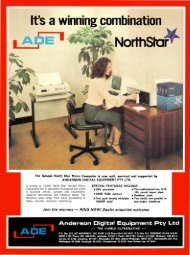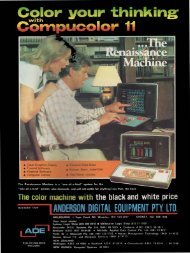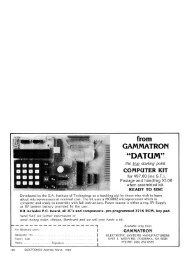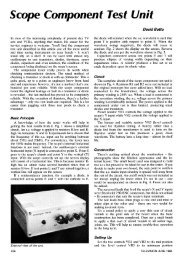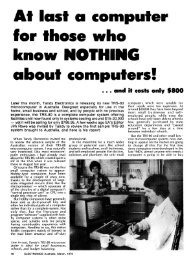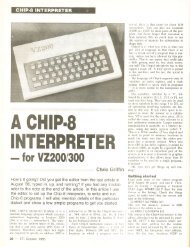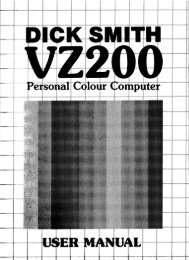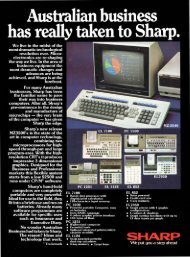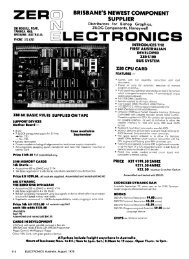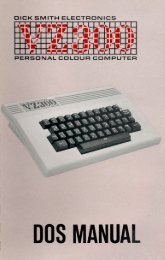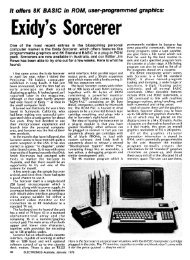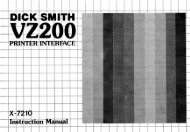MICRO PROCESSOR EVOLUTIONwho was happy to talk about his newprocessors.I sat down on the couch and lookedat the two manuals. <strong>The</strong>y were writtenin English and they made sense!MOS was also showing one more innovationin the suite that night—thefirst multifunction peripheral chips.<strong>The</strong> company had put RAM, ROM,timer, and I/O on one chip. One versionwas called the TIM (terminalinterfacemonitor) chip and containeda complete monitor for talkingto a serial terminal. <strong>The</strong> other was theKIM (keyboard-input monitor) chip,and it was designed into a microcomputerboard that had a keyboard, centralprocessor, display, ROM, RAM,and parallel I/O, and sold for $245. Itwas a complete system. No othermicroprocessor vendor had doneanything like this before. It wasimpressive.I went home that evening clutchingmy $25 6502 microprocessor and twomanuals. At the time I didn't realizeI would spend another $300 to makea working system, not counting theASR-3 3 Teletype I used as a terminal.That first day <strong>of</strong> WESCON, Intel andMotorola lowered the price on theirchips to $69.95. <strong>The</strong> revolution wasin full swing. <strong>The</strong> industry would neverbe the same.<strong>The</strong> 6501 was short-lived. Motorolasued MOS Technology charging thatChuck Peddle had stolen the technologyfrom Motorola and that the6501 infringed because it was plugcompatible.MOS 'Technology agreedto drop the 6501.However, the many computers thatwere developed around the 6502 arenow legend: MOS Technology's ownKIM-1, the Apple I and II, the Atarimodels, and the Commodore PETand VIC-20, among others. Actually,the future <strong>of</strong> the 6502 was still questionablewhen fledgling Apple ComputerInc. produced the Apple I. SteveWozniak put in a jumper connectionthat could be changed to allow the6800 to be used instead <strong>of</strong> the 6502.ENTER THE Z80Sometime in late 1975 or early 1976,Federico Faggin left Intel and formed264 JUST COMPUTERS • DECEMBER 1985his own company, Zilog Inc. He tookMasatoshi Shima with him. <strong>The</strong>ir goalwas to build a super 8080.In 1976, Zilog announced the Z80,a significantly enhanced 8080 that ranalmost all <strong>of</strong> the programs written forthe 8080. <strong>The</strong> company claimed itwould have parts that ran at 4 MHz,twice as fast as the 8080. In additionit had many more powerful instructions—atotal <strong>of</strong> 176. It sounded toogood to be true; the Z80 was treatedwith the same skepticism as the 6502had been.But the Z80 turned out to be real,and there actually were some 4-MHzparts available. <strong>The</strong> early ones said"Engineering Sample" on them andwere manufactured in Dallas, not inSilicon Valley. Mostek, a Z80 secondsource, was actually building the chipsfor Zilog. Nobody minded becauseeverybody wanted one for their owncomputer.Several Z80 cards for the S-100 buswere on the market shortly after thechip became available, and everybodyhad to have one. But even though theZ80 was a much more powerful chipthan the 8080 in terms <strong>of</strong> its instructionset, very few people were writings<strong>of</strong>tware to take advantage <strong>of</strong> theZ80's extra instructions. <strong>The</strong> reasonwas simple: <strong>The</strong> majority <strong>of</strong> themachines installed at that time were8080-based, and if you wrote codethat only ran on a Z80, your marketwould be 'considerably smaller. Thisproblem plagues the Z80 even today.However, designers stopped usingthe 8080 in new computers. <strong>The</strong> Z80was a far easier chip to use, requiringno support ICs and only a singlevoltagepower supply. And it wasmuch faster, even if you didn't use theextra instructions.<strong>The</strong> Z80 introduced one other newconcept to microcomputer chips:built-in support for refreshingdynamic RAMs. Dynamic RAMs havealways cost about four times less perbit than their static counterparts, andthat made th(pm very attractive to use.However. because you have to refreshthem (or else they forget their data),they are extremely difficult to use, andearly system designers viewed themwith some distrust. <strong>The</strong> Z80 gave thedesigner 90 percent <strong>of</strong> the solutionand made it possible to build systemsthat were significantly cheaper thanbefore. <strong>Computers</strong> such as RadioShack's original TRS-80, designed bySteve Leininger, took advantage <strong>of</strong>this fact.INTEL STRIKES BACKMeanwhile Intel had realized that the8080 needed upgrading. In 1976 Intelannounced the 8085. It had all the8080 instructions, plus a few more.But Zilog had taken Intel by surprise.<strong>The</strong> enhancements that the 8085 hadover the 8080 were nowhere near asextensive as those <strong>of</strong> the Z80. Froma purely hardware standpoint, the8085 was a much nicer chip than theZ80, but the Z80 had mass appealbecause it was faster. When introduced,the 8085 ran at 3 MHz, as opposedto the 4-MHz chip that Zilogwas already shipping. Intel had tocome up with something else—a16-bit processor seemed like theanswer.Sixteen-bit processors had beentried before. National Semiconductorhad started work on the IMP-I6 chipset as early as 1972. <strong>The</strong> companyreduced it to one chip called the Pace.and Bill Godbout Electronics announceda Pace-based computer, designedby George Morrow, in mid-1975. <strong>The</strong> unnamed system. a fullblown16-bit computer with RAM anda built-in cassette interface, was advertisedin the first issue <strong>of</strong> BYTE. <strong>The</strong>yactually built one, but it never got tomarket. Bill Godbout said that themarket wasn't ready for a 16-bit computer,and he was probably right.After all, the Altair was only a fewmonths old itself. Neither the Pacechip nor the computer was ever a hit.Other 16-bit chips included GeneralAutomation's LSI-16, a microprocessorversion <strong>of</strong> its SPC-16 minicomputer;DEC's-LSI-11, which was manufacturedby Western Digital and includedthe .PDP-11 instruction set;Western Digital's own WD-11, whichwas only one instruction differentfrom the LS1-11; General Instrument'sCP1600; and 'Texas Instruments'
MICRO PROCESSOR EVOLUTIONTMS9900, which went intotheir home computer, makingit the first mass-market16-bit computer.Interestingly, the firstliterature released by MOSTechnology on the 6502showed some little dashedlines where the 16-bit extensionsto their registerswould go in their 16-bit version<strong>of</strong> the 6502, the 6516.But the 6516 was nevermarketed, and the littledashed lines soon disappeared.<strong>The</strong> existence <strong>of</strong>such a part was rumoredfor years, but it never surfaced.Not until December1983 did the WesternDesign Center [not thesame as Western Digital] announcea 16-bit version <strong>of</strong>the 6502.Again, Intel neededsomething to compete withthe Z80. <strong>The</strong> companyfigured that most previous16-bit designs were flopsbecause they had no existings<strong>of</strong>tware base thatcould easily be migrated toit—they were all the firstmicroprocessor <strong>of</strong>feringsfrom their respective companies.But Intel had an edge: thegrowing base <strong>of</strong> 8080 s<strong>of</strong>tware.<strong>The</strong> company decidedthat its 16-bit processor would be adirect enhancement <strong>of</strong> the 8080. In1976 Intel started work on the 8086.Unfortunately, the designers did notpreserve direct compatibilty with8080 code, but at least each 8080register had its 8086 counterpart,which made 8080-to-8086 code translatorspossible and gave programmersa familiar starting point. This was a bigfactor in the success <strong>of</strong> the 8086,which was announced to the world in1978.<strong>The</strong>n someone at Intel had an inspiration.Why not make the hardwarealmost as easy to migrate as the s<strong>of</strong>tware?Thus was born the 8088. <strong>The</strong>8088 is an 8086 on the inside but has<strong>The</strong> cost <strong>of</strong> 64K bytes <strong>of</strong> RAM from1975 to 1985, as found on the pages <strong>of</strong> BYTEmagazine. Prices shown am for 512 <strong>of</strong> the1-kilobit 5260 chip, 256 <strong>of</strong> the 2-kilobitMM52132 chip, 32 <strong>of</strong> the 2K-byte 4116 chip, and8 <strong>of</strong> the 8K-byte 4164 chip.an 8-bit data bus on the outside.When the processor wants to fetch 16bits <strong>of</strong> data, it first gets 1 byte, thenthe second. <strong>The</strong> programmer doesn'thave to worry about it, it all happensautomatically in the hardware. <strong>The</strong> actualsignals coming out <strong>of</strong> the 8088look similar to the 8085, a chip thatdesigners were already familiar with.Thus, it was easy to upgrade an existing8-bit design to 16 bits.You might think that by doing thisthe processor would run at half itspotential. But Intel had been cleverwhen they designed the 8086. Internallyit consisted <strong>of</strong> two different butlinked processors. One was the executionunit, the part that actually pro-cesses the data or executesthe instructions. <strong>The</strong> otherwas called the bus-interfaceunit (BIU). <strong>The</strong> BIU handlesall communications withthe outside world and is incharge <strong>of</strong> generating addressesand storing andretrieving data from thesystem. Inside the BIU is aqueue. While the executionunit is busy crunching data,the BIU is out on the busgetting the next instructionand putting it in the queue.<strong>The</strong> 8086 BIU can stay upto 6 bytes ahead <strong>of</strong> the executionunit by keepingthose bytes in its queue.Because <strong>of</strong> the queue, the8088 performance only suffersan average <strong>of</strong> 20 percentcompared to an 8086.(See "Benchmarking theIntel 8086 and 8088" byGregg Williams, July 1983BYTE, page 147.) <strong>The</strong> 8086/8088 processors were thefirst to use a queue mechanism.Intel also introduced anothernew concept with its8086 family—coprocessing.<strong>The</strong> idea was to hang anotherprocessor right onthe bus <strong>of</strong> the main processorto extend its. functions.<strong>The</strong> most significant<strong>of</strong> these coprocessors wasthe 8087, a math coprocessor thatadded a whole set <strong>of</strong> floating-point instructionsto the 8086/8088. Since the8087 was built solely to do math, itcould do so very quickly.THE MC68000In 1977, designers at Motorola wereworking on a new processor for the16-bit market but vowing to keep it 32bits internally. <strong>The</strong>y also wanted toeliminate any special-purpose instructionsand allow the processor toperform all operations, on all registers,on all data types, and in alladdressing modes. This is calledorthogonality. Programmers like(continued)BERGMAN HAKE DESIGN INC DECEMBER 1985 • JUST COMPUTERS 265



